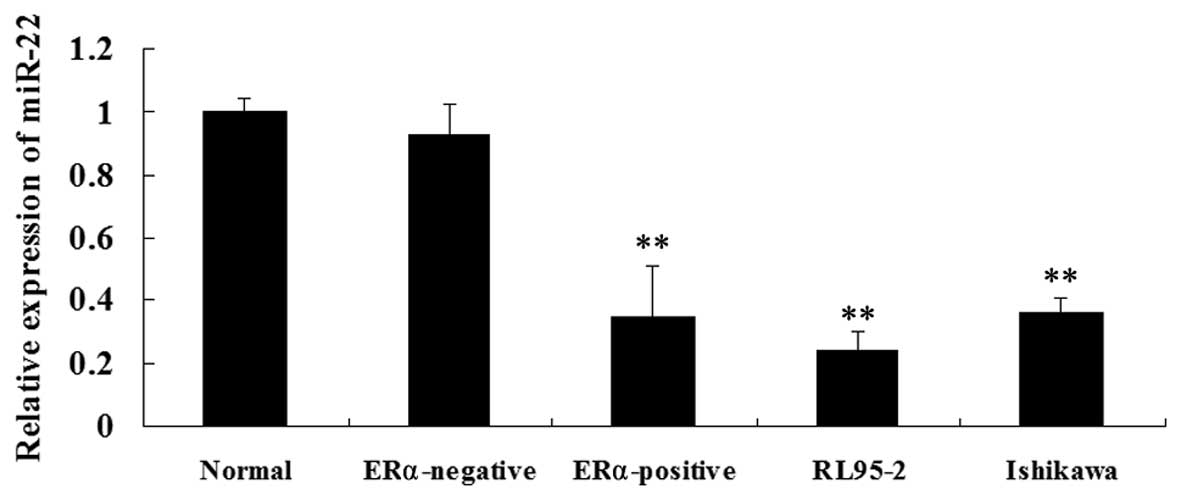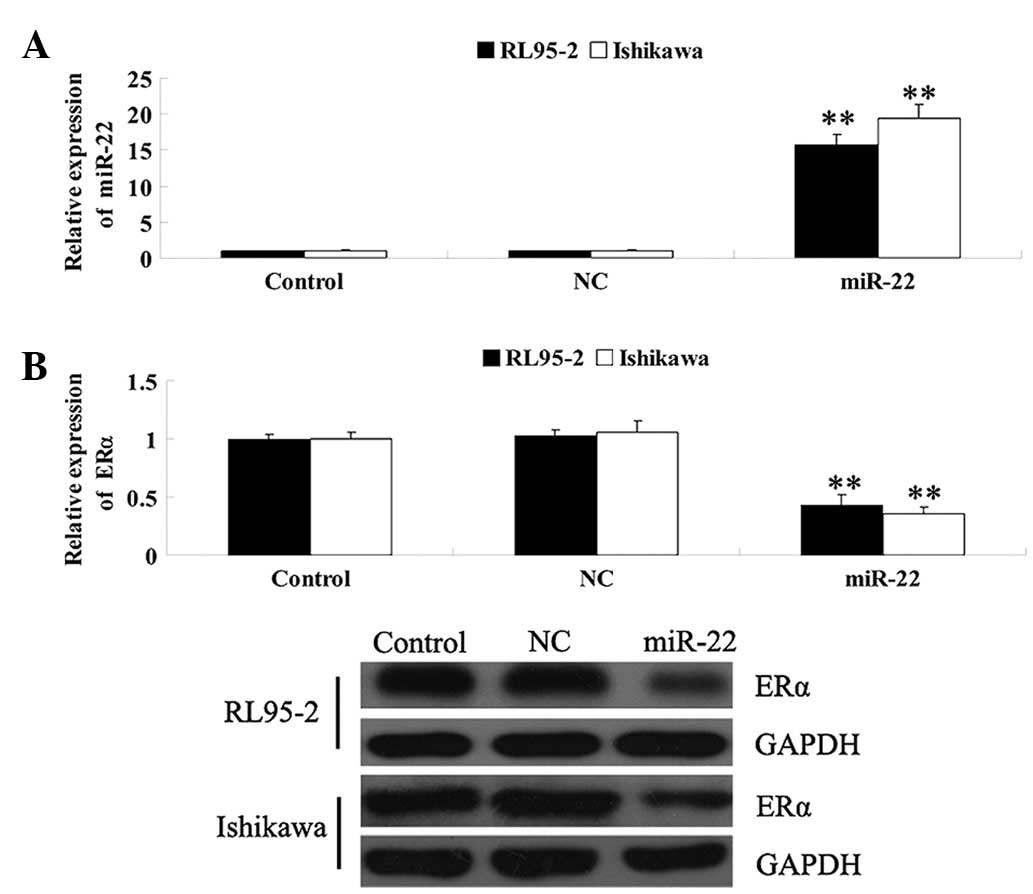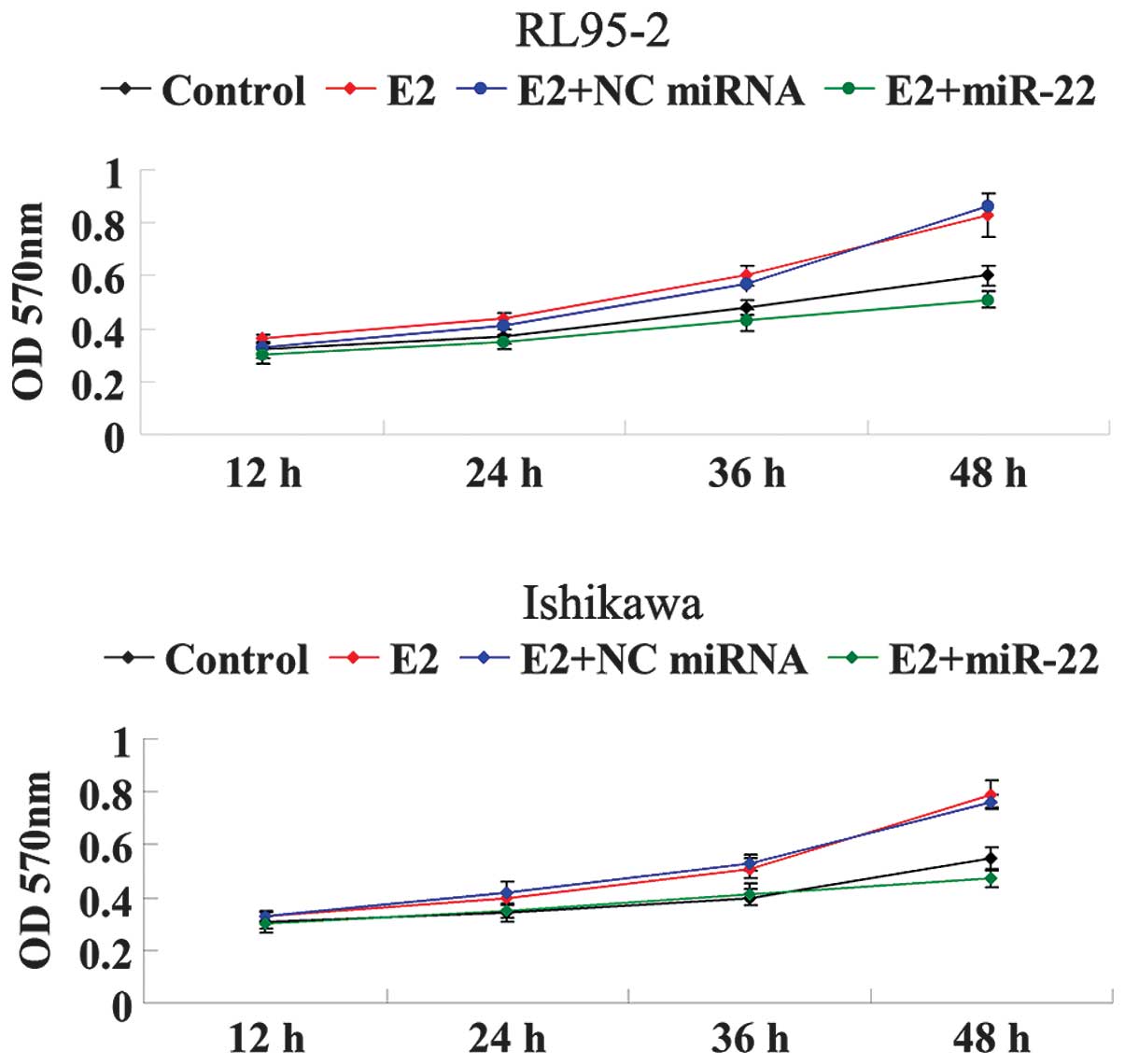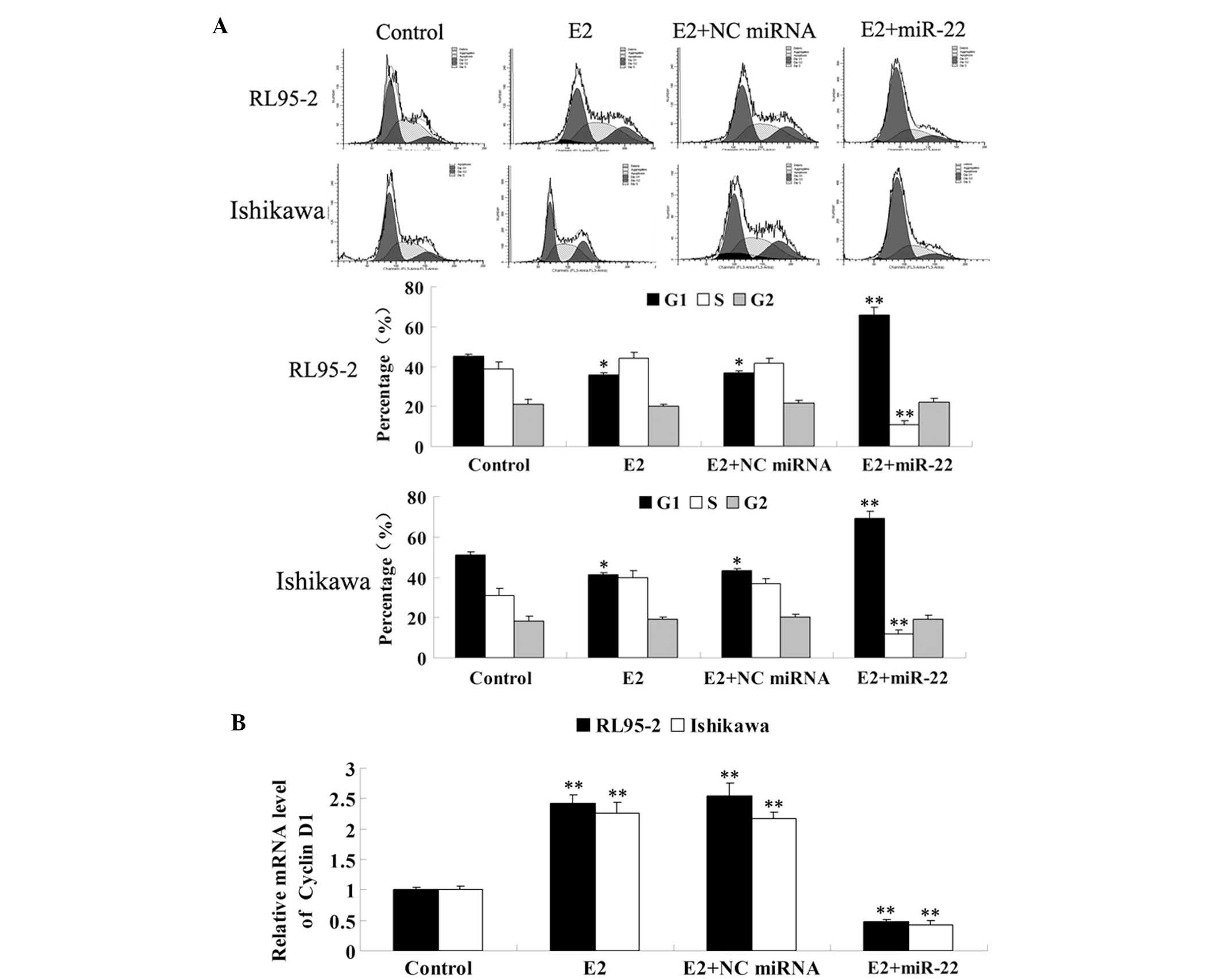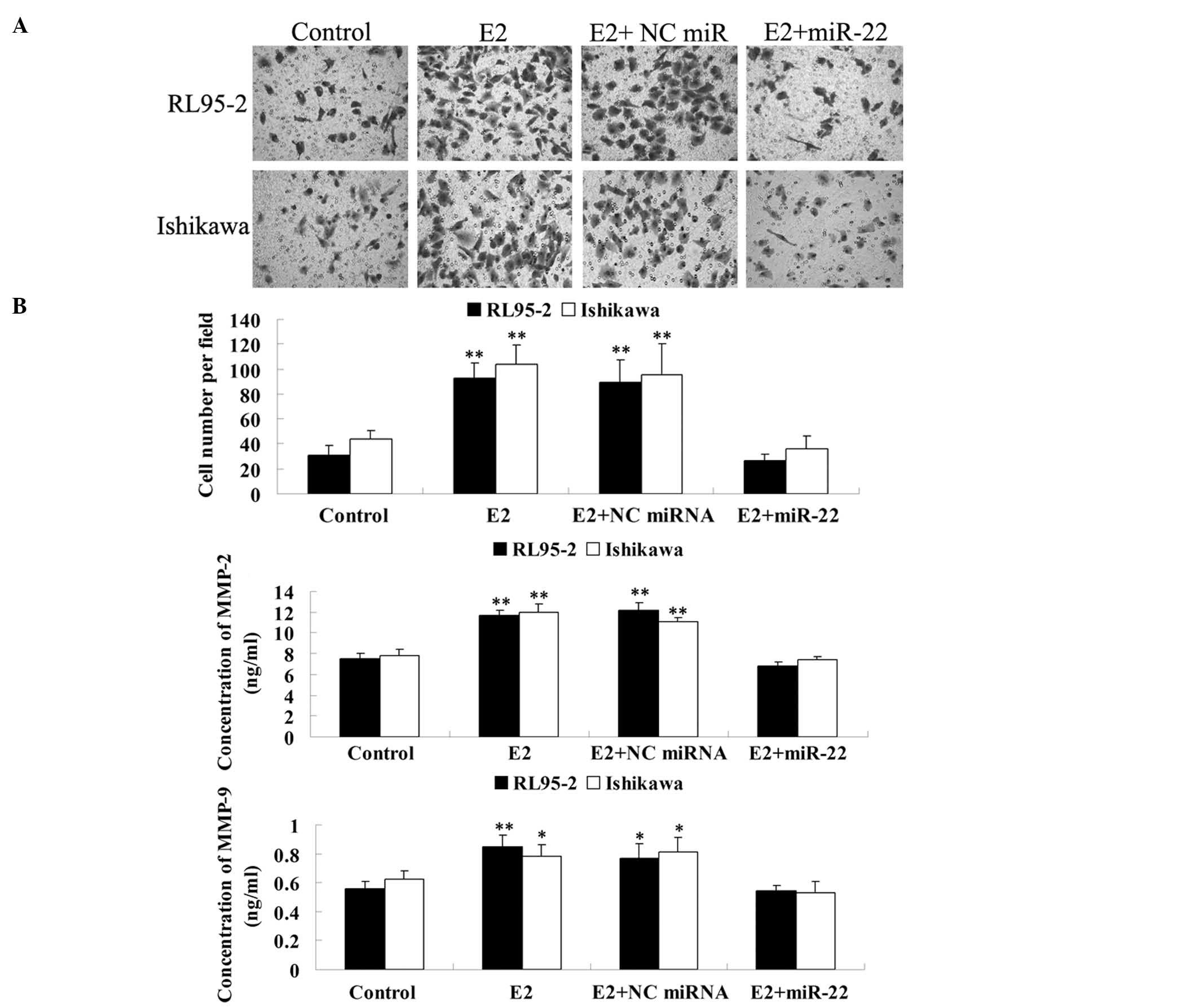miR‑22 inhibits proliferation and invasion in estrogen receptor α-positive endometrial endometrioid carcinomas cells
Retraction in: /10.3892/mmr.2021.12280
- Authors:
- Published online on: April 8, 2014 https://doi.org/10.3892/mmr.2014.2123
- Pages: 2393-2399
Abstract
Introduction
Endometrial carcinomas (ECs) include several types of cancer that arise from the endometrium, or lining, of the uterus (1). Endometrial endometrioid carcinomas (EECs) account for >80% of ECs (2). From a clinical point of view, EECs are the defining example of type I ECs, which often coexist with endometrial hyperplasia (3). In recent decades, the incidence rate of EEC has increased. Furthermore, the age of EEC onset has decreased due to obesity-induced endocrine disturbance (4). Thus, endocrine therapy is often applied, although mainly for the treatment of patients with EEC at terminal or recurrent stages (5).
Estrogen receptor (ER) α, a key mediator of the action of estrogen, is often assessed in order to aid prognosis or the development of a treatment strategy for ECs (6). It has been demonstrated that the continuous stimulation of the endometrium by estrogen is a risk factor for the tumorigenesis of EEC, the majority of which are ERα-positive (7). Thus, ERα is a promising therapeutic target for endocrine-based treatment of EEC (8). However, the exact regulatory role of ERα in EEC remains to be fully elucidated.
MicroRNAs (miRNAs) are a type of endogenous non-coding RNA, which are able to bind to the 3′ untranslated region (UTR) of their target mRNAs causing mRNA degradation or translational repression (9). It is well-established that miRNAs are essential in the regulation of tumorigenesis and progression (10). However, despite increasing studies focusing on miRNA profiles in ECs (11,12), few have attempted to reveal an exact regulatory association between certain miRNAs and ERα in EEC.
miR-22 has been suggested to be involved in the regulation of various types of cancer, including gastric, non-small cell lung, EEC, colon, cervical, hepatocellular and breast cancer (13–18). Notably, miR-22 has been demonstrated to directly target the 3′ UTR of ERα mRNA (19). Thus, the present study hypothesized that miR-22 may have an effect on the expression of ERα in certain types of cancer, including EEC. In order to test this hypothesis, the present study for the first time, to the best of our knowledge, investigated the expression of ERα and miR-22 in EEC and normal endometrium. The present study also investigated the regulatory effects of ERα and miR-22 on EEC cell proliferation, cell cycle progression and invasion in vitro, as well as the underlying molecular mechanisms, which may aid the development of endocrine-based therapies for EEC.
Materials and methods
Reagents and materials
High-glucose Dulbecco’s modified Eagle’s medium (H-DMEM) was purchased from Gibco Laboratories (Grand Island, NY, USA). Fetal bovine serum (FBS), bovine serum albumin (BSA), TRIzol, TaqMan qRT-PCR miRNA assay kit, RT-PCR kit, Lipofectamine 2000, miR-22 mimics and an miR-22 inhibitor were purchased from Thermo Fisher Scientific (Waltham, MA, USA). MTT was purchased from Sigma (St. Louis, MO, USA). SYBR-Green qPCR mix was purchased from Toyobo (Osaka, Japan). Mouse anti-ERα monoclonal antibody, mouse anti-GAPDH monoclonal antibody, rabbit anti-mouse secondary antibody and 17β-estradiol (E2) were purchased from Abcam (Cambridge, UK). Propidium iodide (PI) was purchased from Roche Molecular Biochemicals (Indianapolis, IN, USA). A 24-well transwell chamber was obtained from Corning Inc. (Corning, NY, USA). Matrigel was obtained from BD Biosciences (Franklin Lakes, NJ, USA) and matrix metalloproteinase (MMP)-2 and MMP-9 ELISA kits were purchased from R&D Systems (Minneapolis, MN, USA).
Tissue specimen collection
The present study was approved by the Ethics Committee of Xinxiang Medical University (Weihui, China). Informed consent was obtained from each patient. In total, 20 fresh-frozen EEC tissues were obtained from patients at the Department of Gynecology and Obstetrics, The First Affiliated Hospital of Xinxiang Medical University (Weihui, Henan, China) from May 2011 to May 2012. In addition, 20 normal endometrial tissues were obtained from patients who underwent hysterectomy to treat myoma. Prior to surgery, no patient had undergone hormone therapy, radiotherapy or chemotherapy. Following surgical removal, all samples were immediately snap-frozen in liquid nitrogen and stored at −80°C until use. ERα expression was confirmed by immunohistochemistry.
Cell culture
Human endometrial cancer RL95-2 and Ishikawa cell lines were purchased from the American Type Culture Collection (ATCC, Manassas, VA, USA). Cells were cultured in H-DMEM medium containing 10% FBS at 37°C with 5% CO2. All experiments were performed at the third passage.
RNA extraction and quantitative polymerase chain reaction (qPCR)
Total RNA was extracted from tissues and cells using TRIzol. For the detection of miR-22 expression, RNA was synthesized to cDNA using the RT-PCR kit in accordance with the manufacturer’s instructions. A TaqMan qRT-PCR miRNA assay kit was used to perform qPCR according to the manufacturer’s instructions and analyzed with an ABI 7500 Sequence Detection system. U6 was used as an internal control. For detection of mRNA, qPCR analysis was performed using a SYBR-Green qRCR mix and specific primers synthesized by Sangon Biotech Co., Ltd. (Shanghai, China). The following primers were used for the amplification of ERα: ERα forward, 5′-CCCACTCAACAGCGTGTCTC-3′ and reverse, 5′-CGTCGATTATCTGAATTTGGCCT-3′. GAPDH was used as an internal control. GAPDH forward, 5′-ACAACTTTGGTATCGTGGAAGG-3′ and reverse, 5′-GCCATCACGCCACAGTTTC-3′. Independent experiments were repeated three times for each sample and the relative expression levels of genes were analyzed using the 2−ΔΔCt method.
Western blot analysis
Tissues or cells were solubilized in cold radioimmunoprecipitation assay lysis buffer [1X phosphate-buffered saline (PBS), 1% Nonidet P-40, 0.5% sodium deoxycholate and 0.1% sodium dodecyl sulfate (SDS); Beyotime Institute of Biotechnology, Shanghai, China.]. Protein (20 μg per lane) was separated with 12% SDS-PAGE. Following that, protein was transferred onto nitrocellulose membranes, which were then blocked in 5% non-fat dried milk in PBS containing with Tween 20 for 3 h, and then incubated overnight with mouse anti-ERα monoclonal antibody (1:200) or mouse anti-GAPDH monoclonal antibody (1:400). Following washing with PBS three times (each for 5 min), the membranes were incubated with rabbit anti-mouse secondary antibody (1:20,000) for 1 h at room temperature. Then, the enhanced chemiluminescence kit (Huyu Group, Co., Shanghai, China) was used to detect the immune complexes. Following that, the membranes were scanned for the relative value of protein expression in gray scale using Image-Pro plus software 6.0 (Media Cybernetics, Inc., Rockville, MD, USA). The relative expression levels of protein were presented as the density ratio versus GAPDH.
Transfection
Cells were cultured to 70–80% confluence and then resuspended in serum-free H-DMEM at a concentration of 100,000 cells/ml. Six-well plates were used to inoculate with 2 ml suspension for each well and each group set five duplicate wells. miR-22 mimics (chemically synthesized mature microRNAs) or NC mimics (Thermo Fisher Scientific) of 50 pmol were diluted with 0.25 ml serum-free H-DMEM. Lipofectamine 2000 transfection reagent (50 μl) was diluted with 2.5 ml serum-free H-DMEM. Then, the diluted Lipofectamine 2000 transfection reagent was added to the mimics dilution, mixed gently and incubated for 20 min at room temperature. The cell suspension was washed with serum-free H-DMEM two times and then added to the mixture of Lipofectamine 2000 and the mimics above, and then incubated at 37°C and 5% CO2 for 6 h. Following that, the medium in each well was replaced with the normal serum-containing medium and cultured for 24 h prior to the following experiments.
Cell proliferation assay
For all groups, 10,000 cells per well were seeded in a 96-well plate. Following treatment with 10 nM of E2, the plates were incubated for 12, 24, 36 or 48 h at 37°C and 5% CO2. To assess cell proliferation, an MTT assay was performed according to the manufacturer’s instructions. MTT reagent (50 μl; 5 mg/ml) in PBS was added to each well and incubated for 4 h at 37°C and 5% CO2. Then, the supernatant was removed and 150 μl of dimethylsulfoxide was added. The absorbance was detected at 570 nm with a Microplate Reader (Bio-Rad, Hercules, CA, USA). Each assay was performed in triplicate wells and repeated three times.
Cell cycle progression analysis
At 48 h following transfection, cells were harvested and fixed in 70% ethanol for 30 min. Then the cells were stained with 25 μg/ml propidium iodide (PI) in PBS containing 0.1% BSA, 0.05% of Triton X-100 and 50 μg/ml of RNaseA for 30 min at room temperature. Following that, the cells were analyzed by a FACScan flow cytometer (Becton-Dickinson, Franklin Lakes, NJ, USA). Experiments were performed three times in triplicate.
Cell invasion assay
The cell invasion assay was performed in a 24-well transwell chamber, which was pre-coated with 100 μg Matrigel®. Cells in each group were collected and resuspended in serum-free H-DMEM at a concentration of 10,000 cells/ml, respectively. Then, 0.2 ml cell suspension was added into the upper chamber, and the bottom chamber was filled with 0.5 ml H-DMEM containing 10% FBS. Following incubation for 24 h at 37°C and 5% CO2, a cotton bud was used to remove the cells which had not migrated through the polycarbonate membrane. Then, the cells which had moved through the polycarbonate membrane and adhered to the bottom of it were stained with trypan blue for 15 min, then images were captured (Microscope: CX21BIM-SET5; Olympus, Tokyo, Japan; Camera: DP25; Olympus) and cells were counted.
ELISA
Cell supernatants in each group were used to determine the secretion of MMP-2 and MMP-9 using ELISA. An MMP-2 and MMP-9 ELISA kit were used and the concentrations of MMP-2 and MMP-9 were calculated according to manufacturer’s instructions. Optical density (OD) values were determined using a microplate reader (PR 3100 TSC; Bio-Rad).
Statistical analysis
Statistical analysis was performed using SPSS 17.0 statistical software (SPSS, Inc., Chicago, IL, USA). Data are expressed as the mean ± standard deviation. The data were analyzed by one-way analysis of variance. P<0.05 was considered to indicate a statistically significant difference.
Results
Expression of miR-22 is reduced in ERα-positive EEC tissues and two ERα-positive EEC cell lines
Firstly, the miR-22 expression in ERα-positive and ERα-negative human EEC samples as well as normal endometrium tissues were determined, respectively. As shown in Fig. 1A, miR-22 levels were significantly lower in the ERα-positive ECC tissues as compared with those in normal endometrium and ERα-negative EEC tissues. The miR-22 expression levels were then examined in the ERα-positive ECC lines, RL95-2 and Ishikawa. Consistent with the findings above, miR-22 expression was significantly decreased in RL95-2 and Ishikawa cells compared with that in normal endometrium tissues and ERα-negative EEC tissues (Fig. 1B). These findings suggested that miR-22 may be important in ERα-positive EEC.
miR-22 has an inhibitory effect on ERα expression in RL95-2 and Ishikawa cells
Since ERα has been demonstrated to be a target of miR-22, RL95-2 and Ishikawa cells were further transfected with miR-22 mimics, in order to study the association between miR-22 and ERα in EEC. As shown in Fig. 2A, following transfection with the miR-22 mimics, the expression levels of miR-22 were significantly increased; however, in the control and NC groups, the levels of miR-22 were not affected, suggesting that the introduction of miR-22 into RL95-2 and Ishikawa cells was successful. The mRNA and protein expression of ERα was determined and it was revealed that following transfection of RL95-2 and Ishikawa cells with miR-22 mimics, the mRNA and protein expression levels of ERα were markedly decreased compared with those in the control and the NC groups (Fig. 2B). These findings suggested that miR-22 had an inhibitory effect on the regulation of ERα expression in ERα-positive EEC cell lines.
miR-22 inhibits E2-induced cellular proliferation of RL95-2 and Ishikawa cells
Since RL95-2 and Ishikawa cells have been demonstrated to be ER-dependent, E2 was used to stimulate ER-dependent cellular proliferation. As shown in Fig. 3, the cellular proliferation of RL95-2 and Ishikawa cells was significantly increased under the treatment of E2 in a time-dependent manner. However, following the introduction of miR-22 mimics, the proliferative rate of RL95-2 and Ishikawa cells was markedly decreased as compared with that in the E2 group. These findings suggested that miR-22 inhibited E2-induced proliferation of ERα-positive RL95-2 and Ishikawa cells, at least partially via suppressing ERα expression.
miR-22 inhibited E2-induced cell cycle progression in RL95-2 and Ishikawa cells
Since ER-mediated signaling has been demonstrated to be involved in the regulation of cell cycle progression, the role of miR-22 on the regulation of E2-induced cell cycle progression was further investigated in RL95-2 and Ishikawa cells. As demonstrated in Fig. 4A, E2 significantly promoted cell cycle progression, which was demonstrated by a decrease of cells in G1 phase. However, following the introduction of miR-22 into these cells, the proportion of cells in G1 phase was significantly increased, while the proportion of cells in S phase was decreased, indicating that miR-22 arrested RL95-2 and Ishikawa cells at the G1/S checkpoint and delayed cell cycle entry into S phase.
Cyclin D1 may be a downstream gene of ER-mediated signaling
Notably, cyclin D1 is important in the regulation of the G1/S checkpoint. The aberrant upregulation of cyclin D1 is able to shorten G1 phase and promote cell cycle progression. By contrast, its downregulation may result in a delay of cell cycle progression into S phase. Thus, the mRNA levels of cyclin D1 in each group were examined. As shown in Fig. 4B, E2 significantly upregulated the expression of cyclin D1 in RL95-2 and Ishikawa cells, while the introduction of miR-22 significantly suppressed its expression.
In summary, the findings suggested that miR-22 had an inhibitory effect on E2-stimulated cell cycle progression, at least in part through inducing cyclin D1-mediated cell cycle arrest.
miR-22 inhibits E2-induced cellular invasion of RL95-2 and Ishikawa cells
It has been reported that ER-dependent signaling is important in the regulation of invasion of ER-dependent EEC cells. Thus, transwell chambers precoated with Matrigel were used to study the effect of miR-22 on the invasion ability of ERα-positive RL95-2 and Ishikawa cells. As shown in Fig. 5A, E2 significantly promoted the invasion of RL95-2 and Ishikawa cells, which was effectively reversed by the introduction of miR-22. However, non-specific miRNA had no effect. These findings indicated that miR-22 inhibited E2-induced invasion of ERα-positive RL95-2 and Ishikawa cells, possibly via reducing ERα expression.
Further study was performed to examine the molecular mechanisms involved in the miR-22-induced inhibition of ER-dependent invasion of RL95-2 and Ishikawa cells. Since ER-dependent signaling has been demonstrated to regulate the mRNA and protein expression of MMP-2 and MMP-9 (20), which are key enzymes participating in cellular invasion (21), it was investigated whether miR-22 was able to inhibit E2-induced MMP-2 and MMP-9 secretion in RL95-2 and Ishikawa cells. ELISA data demonstrated that the MMP-2 and MMP-9 protein levels were significantly increased by E2. However, overexpression of miR-22 caused a significant reduction in MMP-2 and MMP-9 secretion (Fig. 5B). These findings suggested that miR-22 inhibited the secretion of MMP-2 and MMP-9 in ERα-positive RL95-2 and Ishikawa cells.
Discussion
The present study for the first time, to the best of our knowledge, demonstrated that the expression of miR-22 was significantly decreased in ERα-positive EEC tissues, as well as in RL95-2 and Ishikawa cell lines, when compared with that in ERα-negative EEC tissues and normal endometrium. Furthermore, the present study also demonstrated that miR-22 was able to effectively reverse E2-induced proliferation, cell cycle progression and invasion in ERα-positive RL95-2 and Ishikawa cells, at least partially through inhibiting the expression of ERα.
Estrogens, including steroid hormone E2, are important in the regulation of various physiological and pathological processes, including development, growth, differentiation and tumorigenesis (22). Furthermore, the coexistence of obesity, diabetes and hypertension is known as the triad of ECs (23). Excessive amounts of fat may increase estrogen storage and promote plasma androstenedione into estrone, which are underlying carcinogenic factors for ECs (24). In fact, these biological effects of estrogens are regulated by ER and the majority of EEC tissues are ERα-positive (7). Knapp et al (25) reported that EEC demonstrated a higher expression of ER compared with healthy mucosa, suggesting that ER may be involved in the development and progression of EEC.
Recently, accumulating studies have reported that the expression levels of numerous miRNAs are deregulated in various types of cancer. These increases or decreases in miRNA expression suggest their crucial roles in cancer. In fact, the altered expression of certain miRNAs has been demonstrated to be involved in tumorigenesis and progression (11,15). Since miR-22 has been revealed to target ERα (19), it was hypothesized that miR-22 may participate in the regulation of estrogen-dependent EEC. The present study preliminarily tested this hypothesis by demonstrating that in ERα-positive EEC tissues and cells, the miR-22 expression was significantly reduced.
Furthermore, the underlying regulatory mechanisms were also investigated. Cyclin D1 is an important protein participating in the regulation of the G1/S phase checkpoint (26). Furthermore, cyclin D1 is a downstream gene of ER-mediated signaling (27,28). Previously, Chen et al (29) demonstrated that miR-206, which also negatively regulates ERα, was able to suppress the expression of cyclin D1 in EEC cells, and induced cell cycle arrest, indicating that similar molecular mechanisms may exist in ERα-positive EEC cells. Thus, the present study suggested that miR-22 inhibited E2-induced cell proliferation, partially by arresting cell cycle progression, via suppressing the expression of cyclin D1.
The present study revealed that miR-22 also downregulated the secretion of MMP-2 and MMP-9 induced by E2 in ERα-positive EEC cells. As is well established, MMP-2 and MMP-9 are two proteases secreted by cancer cells as well as microenvironmental cells, which are crucial in the promotion of invasion and metastasis through complete extracellular matrix breakdown (21). Merlo et al (20) demonstrated that E2 was able to induce the mRNA and protein expression of MMP-2 and MMP-9, as well as the levels of the active forms of the two enzymes released in the medium. Furthermore, several studies have also reported that MMP-2 and MMP-9 are involved in the cell invasion of ERα-positive EEC cells (30,31). Thus, miR-22 was suggested to suppress E2-stimulated cell invasion by inhibiting the secretion of MMP-2 and MMP-9, the expression of which are regulated by estrogen-mediated mechanisms.
In conclusion, the present study demonstrated a tumor suppressive effect of miR-22 in the most common ERα-positive EEC. Notably, as endocrine therapy demonstrates promise for the treatment of EEC, the present study suggested that miR-22 may be a novel candidate for the endocrine therapy of ERα-positive EEC.
References
|
Bartosch C, Manuel Lopes J and Oliva E: Endometrial carcinomas: a review emphasizing overlapping and distinctive morphological and immunohistochemical features. Adv Anat Pathol. 18:415–437. 2011. View Article : Google Scholar : PubMed/NCBI | |
|
Bokhman JV: Two pathogenetic types of endometrial carcinoma. Gynecol Oncol. 15:10–17. 1983. View Article : Google Scholar : PubMed/NCBI | |
|
Tang Q, Jiang X, Li H, et al: Expression and prognostic value of WISP-1 in patients with endometrial endometrioid adenocarcinoma. J Obstet Gynaecol Res. 37:606–612. 2011. View Article : Google Scholar : PubMed/NCBI | |
|
Schouten LJ, Goldbohm RA and van den Brandt PA: Anthropometry, physical activity, and endometrial cancer risk: results from the Netherlands cohort study. Int J Gynecol Cancer. 16(Suppl 2): 4922006. View Article : Google Scholar : PubMed/NCBI | |
|
Mylonas I: Inhibin-alpha subunit expression in uterine endometrioid adenocarcinomas and endometrial cancer cell lines: a potential prognostic factor. Int J Mol Med. 27:309–318. 2011. View Article : Google Scholar | |
|
Shabani N, Kuhn C, Kunze S, et al: Prognostic significance of oestrogen receptor alpha (ERalpha) and beta (ERbeta), progesterone receptor A (PR-A) and B (PR-B) in endometrial carcinomas. Eur J Cancer. 43:2434–2444. 2007. View Article : Google Scholar | |
|
Lin CH, Chen YC, Chiang CJ, et al: The emerging epidemic of estrogen-related cancers in young women in a developing Asian country. Int J Cancer. 130:2629–2637. 2012. View Article : Google Scholar : PubMed/NCBI | |
|
Kaaks R, Lukanova A and Kurzer MS: Obesity, endogenous hormones, and endometrial cancer risk: a synthetic review. Cancer Epidemiol Biomarkers Prev. 11:1531–1543. 2002.PubMed/NCBI | |
|
Ambros V: microRNAs: tiny regulators with great potential. Cell. 107:823–826. 2001. View Article : Google Scholar : PubMed/NCBI | |
|
Chung TK, Cheung TH, Huen NY, et al: Dysregulated microRNAs and their predicted targets associated with endometrioid endometrial adenocarcinoma in Hong Kong women. Int J Cancer. 124:1358–1365. 2009. View Article : Google Scholar : PubMed/NCBI | |
|
Torres A, Torres K, Pesci A, et al: Diagnostic and prognostic significance of miRNA signatures in tissues and plasma of endometrioid endometrial carcinoma patients. Int J Cancer. 132:1633–1645. 2013. View Article : Google Scholar : PubMed/NCBI | |
|
Ramón LA, Braza-Boïls A, Gilabert J, et al: microRNAs related to angiogenesis are dysregulated in endometrioid endometrial cancer. Hum Reprod. 27:3036–3045. 2012.PubMed/NCBI | |
|
Li B, Song Y, Liu TJ, et al: miRNA-22 suppresses colon cancer cell migration and invasion by inhibiting the expression of T-cell lymphoma invasion and metastasis 1 and matrix metalloproteinases 2 and 9. Oncol Rep. 29:1932–1938. 2013.PubMed/NCBI | |
|
Wang W, Li F, Zhang Y, Tu Y, Yang Q and Gao X: Reduced expression of miR-22 in gastric cancer is related to clinicopathologic characteristics or patient prognosis. Diagn Pathol. 8:1022013. View Article : Google Scholar : PubMed/NCBI | |
|
Franchina T, Amodeo V, Bronte G, et al: Circulating miR-22, miR-24 and miR-34a as novel predictive biomarkers to pemetrexed-based chemotherapy in advanced non-small cell lung cancer. J Cell Physiol. 229:97–99. 2013.PubMed/NCBI | |
|
Shi TY, Cheng X, Yu KD, et al: Functional variants in TNFAIP8 associated with cervical cancer susceptibility and clinical outcomes. Carcinogenesis. 34:770–778. 2013. View Article : Google Scholar : PubMed/NCBI | |
|
Jiang R, Deng L, Zhao L, et al: miR-22 promotes HBV-related hepatocellular carcinoma development in males. Clin Cancer Res. 17:5593–5603. 2011. View Article : Google Scholar : PubMed/NCBI | |
|
Patel JB, Appaiah HN, Burnett RM, et al: Control of EVI-1 oncogene expression in metastatic breast cancer cells through microRNA miR-22. Oncogene. 30:1290–1301. 2011. View Article : Google Scholar : PubMed/NCBI | |
|
Pandey DP and Picard D: miR-22 inhibits estrogen signaling by directly targeting the estrogen receptor alpha mRNA. Mol Cell Biol. 29:3783–3790. 2009. View Article : Google Scholar : PubMed/NCBI | |
|
Merlo S and Sortino MA: Estrogen activates matrix metalloproteinases-2 and -9 to increase beta amyloid degradation. Mol Cell Neurosci. 49:423–429. 2012. View Article : Google Scholar : PubMed/NCBI | |
|
Shuman Moss LA, Jensen-Taubman S and Stetler-Stevenson WG: Matrix metalloproteinases: changing roles in tumor progression and metastasis. Am J Pathol. 181:1895–1899. 2012.PubMed/NCBI | |
|
Królik M and Milnerowicz H: The effect of using estrogens in the light of scientific research. Adv Clin Exp Med. 21:535–543. 2012.PubMed/NCBI | |
|
Kulie T, Slattengren A, Redmer J, Counts H, Eglash A and Schrager S: Obesity and women’s health: an evidence-based review. J Am Board Fam Med. 24:75–85. 2011. | |
|
Dossus L, Lukanova A, Rinaldi S, et al: Hormonal, metabolic, and inflammatory profiles and endometrial cancer risk within the EPIC cohort--a factor analysis. Am J Epidemiol. 177:787–799. 2013. View Article : Google Scholar : PubMed/NCBI | |
|
Knapp P, Chabowski A, Blachnio-Zabielska A, Walentowicz-Sadłecka M, Grabiec M and Knapp PA: Expression of estrogen receptors (alpha, beta), cyclooxygenase-2 and aromatase in normal endometrium and endometrioid cancer of uterus. Adv Med Sci. 58:96–103. 2013. View Article : Google Scholar : PubMed/NCBI | |
|
Shirali S, Aghaei M, Shabani M, Fathi M, Sohrabi M and Moeinifard M: Adenosine induces cell cycle arrest and apoptosis via cyclinD1/Cdk4 and Bcl-2/Bax pathways in human ovarian cancer cell line OVCAR-3. Tumour Biol. 34:1085–1095. 2013. View Article : Google Scholar : PubMed/NCBI | |
|
Wang X and Zou S: The relationship of CyclinD1 and estrogen receptor expression in the process of proliferation and metastasis in breast neoplasm. J Tongji Med Univ. 21:231–232. 2001. View Article : Google Scholar : PubMed/NCBI | |
|
Penttinen P, Jaehrling J, Damdimopoulos AE, et al: Diet-derived polyphenol metabolite enterolactone is a tissue-specific estrogen receptor activator. Endocrinology. 148:4875–4886. 2007. View Article : Google Scholar : PubMed/NCBI | |
|
Chen X, Yan Q, Li S, et al: Expression of the tumor suppressor miR-206 is associated with cellular proliferative inhibition and impairs invasion in ERalpha-positive endometrioid adenocarcinoma. Cancer Lett. 314:41–53. 2012. View Article : Google Scholar | |
|
Brucka A and Szyłło K: Immunoexpression of the PTEN protein and matrix metalloproteinase-2 in endometrial cysts, endometrioid and clear cell ovarian cancer. Ginekol Pol. 84:344–351. 2013.PubMed/NCBI | |
|
Puljiz M, Puljiz Z, Vucemilo T, et al: Prognostic significance of matrix metalloproteinases 2 and 9 in endometrial cancer. Coll Antropol. 36:1367–1372. 2012.PubMed/NCBI |



